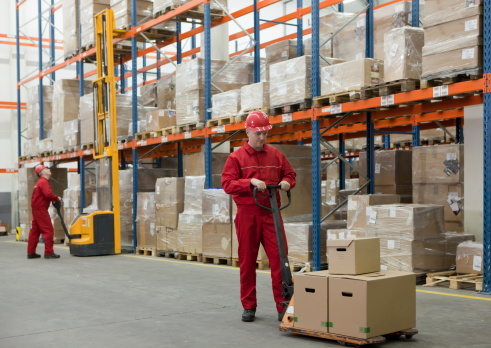Pallets are designed to bear thousands of pounds. Often times the unit loads are stacked up to three pallets high or racked in warehouses without supporting structures. When handled properly, they do so safely. However due to the enormous loads they are responsible for moving, warehouse and shipping staff should take caution when handling pallets in order to avoid injury to themselves or fellow workers. It’s also important for staff to be trained on and watching for the telltale signs of an unstable pallet.
Lift with Your Legs, or a Forklift Preferably
Pallets themselves can be fairly heavy, and a loaded pallet can easily weigh over one ton. It is always advisable to lift pallets with a forklift or a pallet jack. Doing so protects from back injuries and is also the most controlled method of moving pallets. Lifting a pallet by hand can easily cause strain and even crush injuries if the pallet is dropped, so teaching staff to use proper lifting techniques will prevent on-the-job injuries and the associated expenses.
Wear Gloves to Protect Against Sharp Bits
The wood used in pallets is not finished to prevent splinters. Fasteners can also protrude from the wood and can snag bare skin. To avoid potentially serious puncture wounds as well as painful splinters, employees should be mandated to wear gloves whenever handling pallets.
Check Your Stacking and Racking Conditions
If you store pallets by stacking, there is a potential for them to topple. To avoid this disaster, do not stack pallets too high. Also make sure that your staff use proper stacking techniques; do not put a lesser-loaded pallet on bottom and a heavier pallet on top. This can cause the stack to topple, potentially causing severe injury.
Proper racking conditions should also be maintained. First, make sure that your using pallets that are designed for the racking system you have in place. Follow the protocols given by the Pallet Design System to prevent pallet failure. For example, if PDS determines that maximum safe load when racking across stringers (RAS) to be 500 pounds, don’t rack a unit load that weighs 1,000 pounds or it will likely fail.
If You See These Danger Signs, The Pallet May Not Be Safe
There are several indicators that a pallet is about to fail, or has the potential to fail. If you recognize any of these, you should not use the pallet. If it is already loaded, move the load to a new pallet.
- Large cracks or splits on the stringers or the deck boards not contained by fasteners
- Shiners, or nails protruding out of the wood
- Rot or loose large knots
- Deflection on the deckboards – if it is more than 1/2 inch, you may have an issue with pallet failure
- Lateral collapse – indicated by the top deckboard and bottom deckboard going in opposite directions, and is an indicator of stinger failure
By keeping an eye out for these danger signs and following the safety tips above, you can prevent the most common injuries – and expenses – associated with pallet handling.
